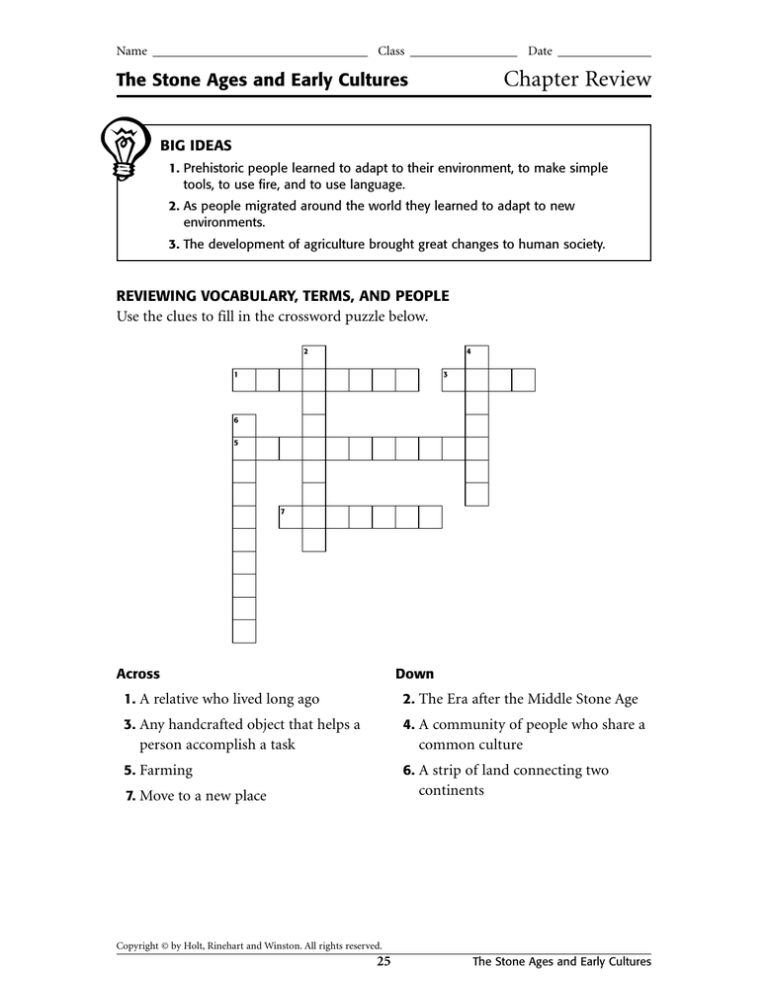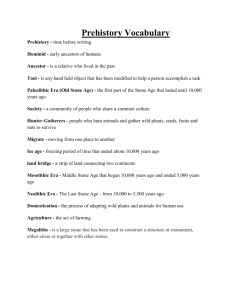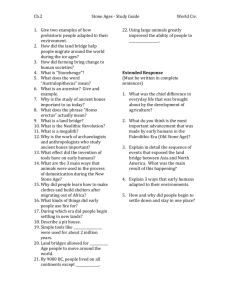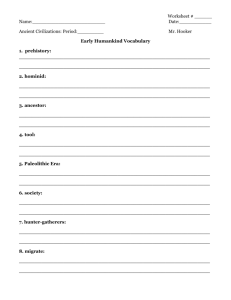
Name
Class
Date
Chapter Review
The Stone Ages and Early Cultures
BIG IDEAS
1. Prehistoric people learned to adapt to their environment, to make simple
tools, to use fire, and to use language.
2. As people migrated around the world they learned to adapt to new
environments.
3. The development of agriculture brought great changes to human society.
REVIEWING VOCABULARY, TERMS, AND PEOPLE
Use the clues to fill in the crossword puzzle below.
2
4
1
3
6
5
7
Across
Down
1. A relative who lived long ago
2. The Era after the Middle Stone Age
3. Any handcrafted object that helps a
4. A community of people who share a
person accomplish a task
common culture
5. Farming
6. A strip of land connecting two
continents
7. Move to a new place
Copyright © by Holt, Rinehart and Winston. All rights reserved.
25
The Stone Ages and Early Cultures
Name
Class
Date
Chapter Review
The Stone Ages and Early Cultures, continued
COMPREHENSION AND CRITICAL THINKING
Read each pair of people or events. Circle the one that occurred first.
1. Paleolithic Era OR Neolithic Era
2. human OR hominid
3. tools OR megaliths
4. hunter-gatherers OR agriculture
REVIEWING THEMES
In the space provided, explain how each term relates to the theme listed
below.
Theme: geography
1. ice ages ___________________________________________________________
2. land bridge ________________________________________________________
REVIEW ACTIVITY: FACT PICTURE
Choose one of the facts below about early cultures, and on a separate
sheet of paper draw a picture about it. You can use your book and other
resources for help.
1. Lucy was a hominid that lived more than 3 million years ago. Her bones were
small and she walked on two legs.
2. During the Paleolithic Era, humans used stone tools. These sharpened stones were
used to cut, chop, or scrape.
3. People learned how to attach wooden handles to tools. By attaching a wooden
handle to a stone arrow, they invented the spear, which they used for hunting.
4. Early humans were hunter-gatherers, that is, people who hunt animals gather wild
plants, seeds, fruits, and nuts to survive. Men were the hunters while women took
responsibility for collecting plants and fruits.
5. During the Stone Age, people expressed themselves through art. They painted and
carved images of people and animals on rocks and cave walls.
Copyright © by Holt, Rinehart and Winston. All rights reserved.
26
The Stone Ages and Early Cultures
Answer Key
Social Studies Skills
PRACTICE THE SKILL
1. that Neandertals and humans shared some
cultural traits
2. It is the first sentence and the other two
are supportive of it.
3. 1
4. It is material provided to support the
central issue.
Chapter Review
REVIEWING VOCABULARY, TERMS,
AND PEOPLE
Across:
1. ancestor
3. tool
5. agriculture
7. migrate
Down:
2. Neolithic
4. society
6. landbridge
COMPREHENSION AND CRITICAL
THINKING
1.
2.
3.
4.
Paleolithic Era
hominid
tools
hunter-gatherers
REVIEWING THEMES
1. The term “ice ages,” relates to the theme,
“geography” in the following ways: huge
sheets of ice covered the surface of the
earth; ice sheets reduced ocean levels
exposing greater amounts of dry land,
such as the land bridge that enabled the
first migration into the Americas.
2. The term “land bridge,” relates to the
theme, “geography” in the following way:
the land bridge, is itself an example of a
geographic feature.
REVIEW ACTIVITY: FACT PICTURE
Answers will vary but should depict one of the
five facts listed on the worksheet.
Copyright © by Holt, Rinehart and Winston. All rights reserved.
33
The Stone Ages and Early Cultures







